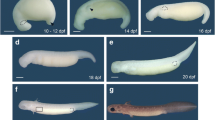Summary
In the chick embryo, the tail bud reaches its maximum length at about stage 22 of Hamburger and Hamilton, after which it starts to regress. By this stage the neural tube and notochord extend right to the tip of the tail, but the somites do not do so, the terminal tail bud mesoderm never becoming segmented. The investigation is concerned with analysing why this mesoderm fails to segment. When tail buds were explanted to the chorio-allantoic membrane, they continued to form somites only until the “correct” number had segmented, i.e., the tail bud formed no more somites when isolated from the embryo than it would have formed if undisturbed. Morphological studies suggest that in the normal embryo massive cell death overtakes the tail bud mesoderm before it can segment. It is suggested therefore that cell death may be a contributory factor in preventing segmentation.
Similar content being viewed by others
References
Amprino R, Amprino Bonetti D, Ambrosi G (1969) Observations on the developmental relations between ectoderm and mesoderm of the chick embryo tail. Acta Anat [Suppl] 56:1–26
Bellairs R (1985) A new theory about somite formations. In: J. Lash, L. Saxén (eds) Developmental mechanisms normal and abnormal. Liss, New York, pp 25–44
Criley BB (1969) Analysis of the embryonic sources and mechanisms of development of posterior levels of chick neural tube. J Morphol 128:465–502
Fallon JF, Simondl BK (1978) Evidence of a role for cell death in the disappearance of the embryonic human tail. Am J Anat 152:111–130
Gaertner RA (1949) Development of the posterior trunk and tail of the chick embryo. J Exp Zool 111:157–174
Glücksmann A (1951) Cell death in normal vertebrate ontogeny. Biol Dev Camb Philos Soc 26:59–86
Hamburger V, Hamilton HL (1951) A series of normal stages in the development of the chick embryo. J Morphol 88:49–82
Hinchliffe JR (1981) Cell death in embryogenesis In: Bowen ID, Lockshin RA (eds) Cell death in biology and pathology. Chapman and Hall, London New York, pp 35–78
Holmdahl DE (1925) Experimentelle Untersuchungen über die Lage der Grenze primärer und sekundärer Körperentwicklung beim Huhn. Anat Anz Bd 59:393–396
Klika E, Jelinek R (1969) The structure of the end and tail bud of the chick embryo. Folia Morphol (Prague) 17:29–40
Lash JW (1985) Somitogenesis: investigations on the mechanism of compaction in the presomitic mass and a possible role for fibronectin. In: Lash JW, Saxén L (eds) Developmental mechanisms: normal and abnormal. Liss, New York, pp 45–60
Mahoney R (1963) The use of Anthracene Blue for staining whole mounts of zoological material. J Sci Technol 9:154–155
Meier S (1979) Development of the chick embryo mesoblast. Formation of the embryonic axis and establishment of the metameric pattern. Dev Biol 73:25–45
Moseley HR (1947) Insulin-induced rumplessness of chickens. IV. Early embryology. J Exp Zool 105:279–316
Pannet CA, Compton A (1924) The cultivation of tissues in saline embryonic juice. Lancet I:381–384
Romanoff AL (1960) The avian embryo. Macmillan, London New York
Saunders JW Jr, Fallon JF (1967) Cell death in morphogenesis. In: Locke M (ed) Major problems in developmental biology. Academic Press, London, pp 289–314
Saunders JW Jr, Gasseling MT, Saunders LC (1962) Cellular death in morphogenesis of the avian wing. Dev Biol 5:147–178
Schoenwolf GC (1977) Tail (end) bud contributions to the posterior region of the chick embryo. J Exp Zool 201:227–246
Schoenwolf GC (1979) Histological and ultrastructural observations of tail bud formation in the chick embryo. Anat Rec 193:131–148
Schoenwolf GC (1981) Morphogenetic processes involved in the remodelling of the tail region of the chick embryo. Anat Embryol 162:183–197
Seevers CH (1932) Potencies of the end bud and other caudal levels of the early chick embryo, with special reference to the origin of the metanephros. Anat Rec 54: 217–246
Tam PPL (1985) The histogenetic capacity of tissues in the caudal end of the embryonic axis of the mouse. J Embryol Exp Morphol 82:253–266
Van Horn JR (1971) A study of degeneration of the tailgut in the chick embryo. Acta Morphol Neerl Scand 8:234–235
Williams LW (1910) The somites of the chick. Am J Anat 11:55–100
Zwilling E (1942) The embryogeny of a recessive rumpless condition of chickens. J Exp Zool 99:79–91
Author information
Authors and Affiliations
Rights and permissions
About this article
Cite this article
Sanders, E.J., Khare, M.K., Ooi, V.C. et al. An experimental and morphological analysis of the tail bud mesenchyme of the chick embryo. Anat Embryol 174, 179–185 (1986). https://doi.org/10.1007/BF00824333
Accepted:
Issue Date:
DOI: https://doi.org/10.1007/BF00824333




